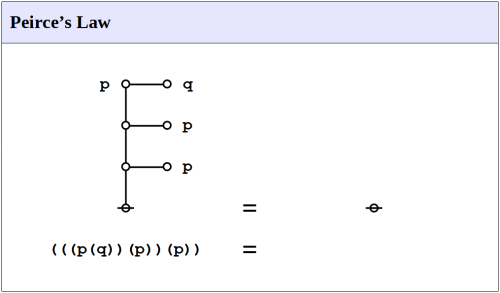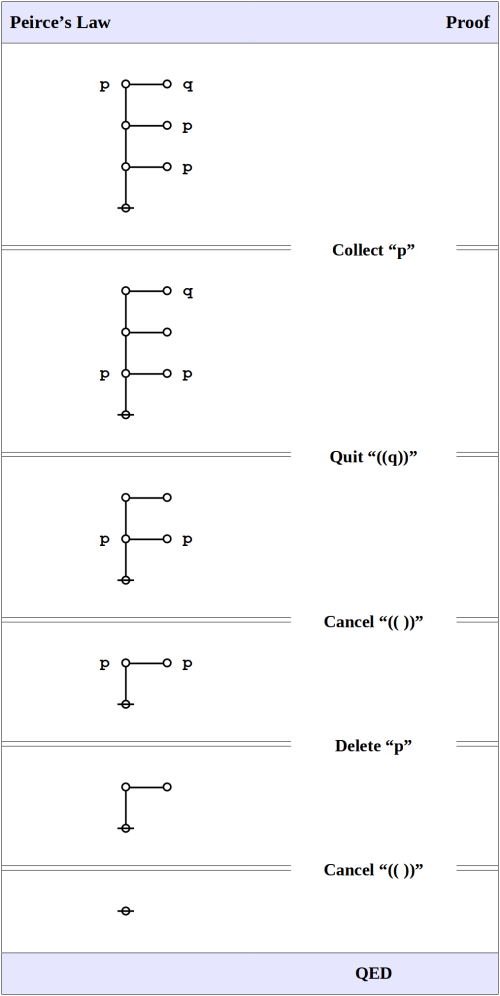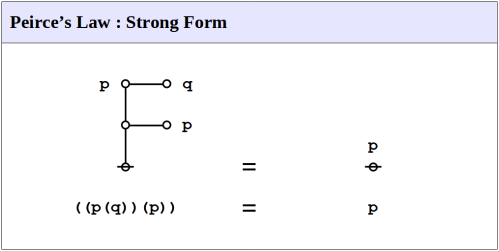A Curious Truth of Classical Logic
Peirce’s law is a propositional calculus formula which states a non‑obvious truth of classical logic and affords a novel way of defining classical propositional calculus.
Introduction
Peirce’s law is commonly expressed in the following form.
Peirce’s law holds in classical propositional calculus, but not in intuitionistic propositional calculus. The precise axiom system one chooses for classical propositional calculus determines whether Peirce’s law is taken as an axiom or proven as a theorem.
History
Here is Peirce’s own statement and proof of the law:
A fifth icon is required for the principle of excluded middle and other propositions connected with it. One of the simplest formulae of this kind is:
This is hardly axiomatical. That it is true appears as follows. It can only be false by the final consequent being false while its antecedent
is true. If this is true, either its consequent,
is true, when the whole formula would be true, or its antecedent
is false. But in the last case the antecedent of
that is
must be true. (Peirce, CP 3.384).
Peirce goes on to point out an immediate application of the law:
From the formula just given, we at once get:
where the is used in such a sense that
means that from
every proposition follows. With that understanding, the formula states the principle of excluded middle, that from the falsity of the denial of
follows the truth of
(Peirce, CP 3.384).
Note. Peirce uses the sign of illation for implication. In one place he explains
as a variant of the sign
for less than or equal to; in another place he suggests that
is an iconic way of representing a state of affairs where
in every way that it can be, is
Graphical Representation
Representing propositions in the language of logical graphs, and operating under the existential interpretation, Peirce’s law is expressed by means of the following formal equivalence or logical equation.
Graphical Proof
Using the axiom set given in the articles on logical graphs, Peirce’s law may be proved in the following manner.
The following animation replays the steps of the proof.
Equational Form
A stronger form of Peirce’s law also holds, in which the final implication is observed to be reversible, resulting in the following equivalence.
The converse implication is clear enough on general principles, since
holds for any proposition
Representing propositions as logical graphs under the existential interpretation, the strong form of Peirce’s law is expressed by the following equation.
Using the axioms and theorems listed in the entries on logical graphs, the equational form of Peirce’s law may be proved in the following manner.
The following animation replays the steps of the proof.
References
- Peirce, Charles Sanders (1885), “On the Algebra of Logic : A Contribution to the Philosophy of Notation”, American Journal of Mathematics 7 (1885), 180–202. Reprinted (CP 3.359–403), (CE 5, 162–190).
- Peirce, Charles Sanders (1931–1935, 1958), Collected Papers of Charles Sanders Peirce, vols. 1–6, Charles Hartshorne and Paul Weiss (eds.), vols. 7–8, Arthur W. Burks (ed.), Harvard University Press, Cambridge, MA. Cited as (CP volume.paragraph).
- Peirce, Charles Sanders (1981–), Writings of Charles S. Peirce : A Chronological Edition, Peirce Edition Project (eds.), Indiana University Press, Bloomington and Indianapolis, IN. Cited as (CE volume, page).
Resources
- Logic Syllabus • Logical Graphs • Peirce’s Law
- Metamath Proof Explorer • Peirce’s Axiom
- Charles Sanders Peirce • Bibliography
cc: FB | Logical Graphs • Laws of Form • Mathstodon • Academia.edu
cc: Conceptual Graphs • Cybernetics • Structural Modeling • Systems Science







Pingback: Logical Graphs : 2 | Inquiry Into Inquiry
Pingback: Alpha Now, Omega Later : 1 | Inquiry Into Inquiry
Pingback: Charles Sanders Peirce, George Spencer Brown, and Me • 5 | Inquiry Into Inquiry
Pingback: Peirce’s 1903 Lowell Lectures • Comment 1 | Inquiry Into Inquiry
Pingback: Survey of Animated Logical Graphs • 2 | Inquiry Into Inquiry
Pingback: Logical Graphs • 2 | Inquiry Into Inquiry
Pingback: Survey of Animated Logical Graphs • 3 | Inquiry Into Inquiry
Pingback: Animated Logical Graphs • 38 | Inquiry Into Inquiry
Pingback: Animated Logical Graphs • 51 | Inquiry Into Inquiry
Pingback: Survey of Animated Logical Graphs • 4 | Inquiry Into Inquiry
Pingback: Animated Logical Graphs • 78 | Inquiry Into Inquiry
Pingback: Survey of Animated Logical Graphs • 5 | Inquiry Into Inquiry
Pingback: Logical Graphs • Formal Development | Inquiry Into Inquiry
Pingback: Logical Graphs • Formal Development 8 | Inquiry Into Inquiry
Pingback: Survey of Animated Logical Graphs • 6 | Inquiry Into Inquiry